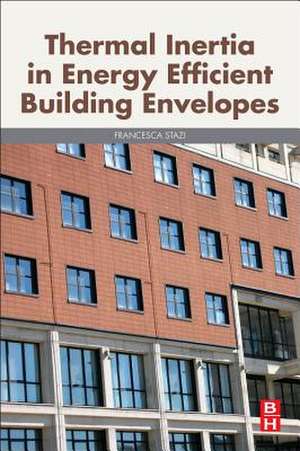Thermal Inertia in Energy Efficient Building Envelopes
Autor Francesca Stazien Limba Engleză Paperback – 30 aug 2017
Thermal Inertia in Energy Efficient Building Envelopes provides experimental data, technical solutions and methods for quantifying energy consumption and comfort levels, also considering dynamic strategies such as thermal inertia and natural ventilation. Several type of envelopes and their optimal solutions are covered, including retrofit of existing envelopes, new solutions, passive systems such as ventilated facades and solar walls. The discussion also considers various climates (mild or extreme) and seasons, building typology, mode of use of the internal environment, heating profiles and cross-ventilation
- Experimental investigations on real case studies, to explore in detail the behaviour of different envelopes
- Laboratory tests on existing insulation to quantify the actual performances
- Analytical simulations in dynamic conditions to extend the boundary conditions to other climates and usage profiles and to consider alternative insulation strategies
- Evaluation of solutions sustainability through the quantification of environmental and economic impacts with LCA analysis; including global cost comparison between the different scenarios
- Integrated evaluations between various aspects such as comfort, energy saving, and sustainability
Preț: 551.04 lei
Preț vechi: 726.94 lei
-24% Nou
Puncte Express: 827
Preț estimativ în valută:
105.46€ • 109.69$ • 87.06£
105.46€ • 109.69$ • 87.06£
Carte tipărită la comandă
Livrare economică 07-21 aprilie
Preluare comenzi: 021 569.72.76
Specificații
ISBN-13: 9780128139707
ISBN-10: 0128139706
Pagini: 374
Dimensiuni: 152 x 229 x 28 mm
Editura: ELSEVIER SCIENCE
ISBN-10: 0128139706
Pagini: 374
Dimensiuni: 152 x 229 x 28 mm
Editura: ELSEVIER SCIENCE
Public țintă
Civil Engineers, Mechanical engineers, Architects, Construction Project Managers, Building service and energy control engineers, Energy auditors and managers, and Environmental Engineers.Cuprins
1. High thermal resistance versus high thermal capacity: The dilemma2. The envelope: A complex and dynamic problem3. Retrofit of existing envelopes4. New envelopes5. Passive envelopes6. Methods: Experimental surveys, analytic explorations and model reliability
